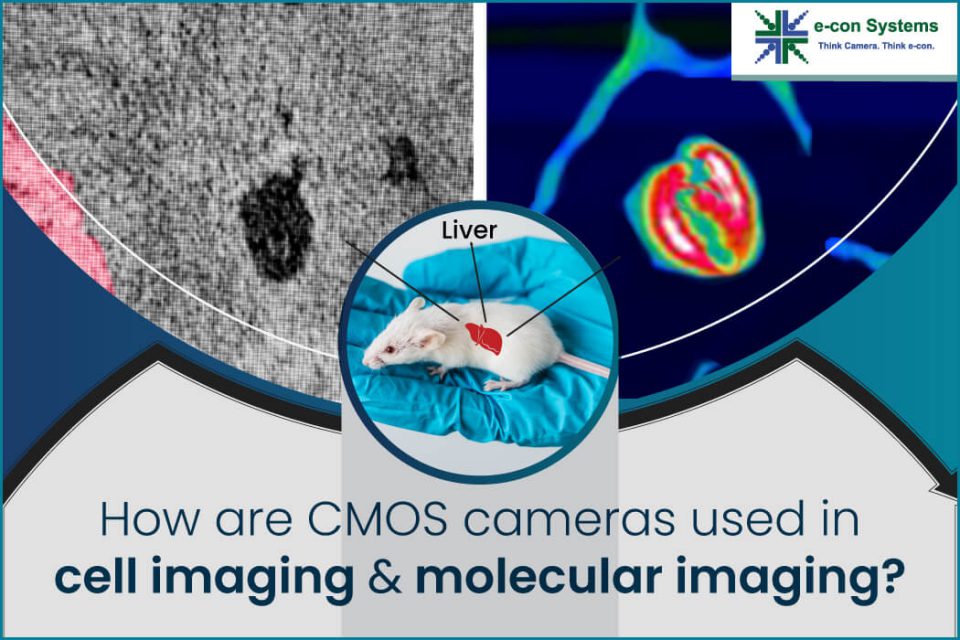CMOS cameras have created a significant impact in the fields of cell imaging and molecular imaging. So, researchers worldwide have gathered more accurate and detailed information about cellular and molecular processes. Previously, they could only use traditional eyepiece-based microscopes – which came with several shortcomings.
Hence, CMOS cameras have undoubtedly led to major advancements in the human understanding of cellular and molecular biology – paving the way for new therapeutic approaches in medicine.
What are CMOS cameras?
These cameras are equipped with the highly popular CMOS (Complementary Metal-Oxide-Semiconductor) sensors that use the photoelectric effect to convert packets of light (or photons) into electric signals. They are also made up of pixel wells to collect incoming photons – similar to CCD sensors. However, what makes them different is how they recreate images from electric signals. They are gaining popularity due to reasons such as reduced costs, better imaging in low-light conditions and NIR regions, lower power consumption, and higher market availability.
How are CMOS cameras used in cell imaging and molecular imaging?
CMOS cameras can seamlessly capture high-quality images of cells and molecular structures. It’s why these cameras have several advantages over traditional eyepiece-based microscopes like:
- Higher sensitivity
- Lower noise
- Faster imaging speeds
CMOS cameras are used in cell imaging to capture images of living cells. It includes their morphology, movements, and interactions with other cells or substances. Thanks to these cameras, it is performed in real-time – often with fluorescence-based techniques. This enables researchers to visualize specific cellular structures or processes.
In molecular imaging, CMOS cameras are leveraged to capture images of individual molecules or molecular complexes. It involves the use of fluorescence or other labeling techniques – allowing researchers to visualize the location and movement of individual molecules in real time.
What are the must-have camera features for effective cell imaging and ?
There are several key camera features that are important for cell imaging and molecular imaging. These include:
- High sensitivity: High sensitivity is a must-have camera feature across cell imaging and molecular imaging fields. The reason is that embedded vision applications are required to capture images in low-light conditions when observing cells and molecular interactions.
- HDR (High Dynamic Range): A wide dynamic range is crucial to capture both bright and dim signals. It is especially important since varying lighting conditions are likely to be a common occurrence during the cell and molecular imaging process.
- High resolution: A high-resolution camera is necessary to capture images with fine detail. So, this feature can go a long way to help accurately analyze cells and molecular structures without losing valuable details due to poor imaging resolutions.
- Low noise: A low-noise camera is important to minimize image degradation. It ensures that the resulting images are of high quality, which can be a make-or-break moment in cell and molecular imaging – given the earlier-mentioned importance of capturing fine details.
- High imaging speed: High-speed cameras are an unquestionable feature, as only they would be able to match up to imaging expectations. They must capture fast-moving interactions that tend to occur during the cell and molecular imaging process.
e-con Systems offers high-performance CMOS cameras for cell and molecular imaging
Choosing the right camera is the most crucial aspect of successful imaging in both cell and molecular imaging. It’s why you need a specialist to guide you through the process – from planning to deployment.
For nearly two decades, e-con Systems has successfully designed, developed, and launched several top-quality cameras – designed for cell imaging and molecular imaging. Our clients have deployed them in embedded vision applications to solve complex research challenges, provide accurate diagnostics, and help improve the patient treatment experience.
Some of our CMOS cameras are:
- e-CAM180_CUMI1820_MOD – 18 MP AR1820HS MIPI Camera Module
- e-CAM131_CUMI1335_MOD – 13MP 4K Camera Module
- e-CAM120_CUMI477C_MOD – 12MP Sony® IMX477 Camera Module
- -CAM120_CUMI412C_MOD – Sony® Starvis™ IMX412 Camera Module
- e-CAM84_CUMI485C_MOD – Sony® Starvis™ IMX485 Ultra-Lowlight Camera Module
- e-CAM82_CUMI0821_MOD – 8MP (4K) HDR MIPI Camera Module
- See3CAM_50CUGM – 5MP Sony Pregius IMX264 Monochrome Global Shutter Camera
- e-CAM55_CUMI0521_MOD – 5MP AR0521 MIPI Camera Module
- e-CAM519_CUMI335_MOD – Sony® Starvis™ IMX335 Camera Module
If you are interested in integrating embedded cameras into your products, kindly write to us at camerasolutions@e-consystems.com. You could also visit our Camera Selector to get a complete view of e-con Systems’ camera portfolio.

Balaji is a camera expert with 18+ years of experience in embedded product design, camera solutions, and product development. In e-con Systems, he has built numerous camera solutions in the field of ophthalmology, laboratory equipment, dentistry, assistive technology, dermatology, and more. He has played an integral part in helping many customers build their products by integrating the right vision technology into them.




